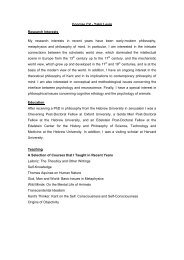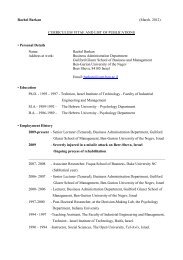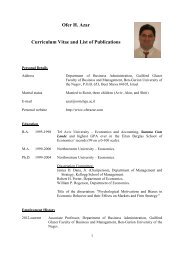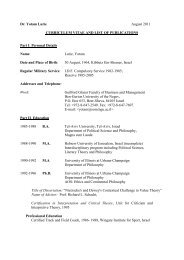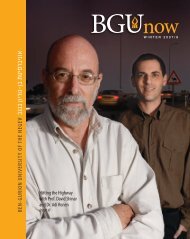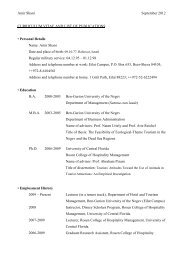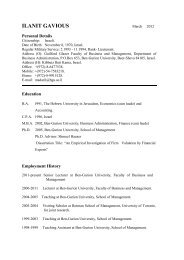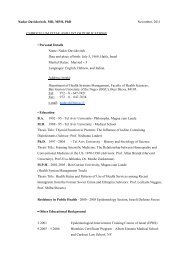cover 2006
cover 2006
cover 2006
Create successful ePaper yourself
Turn your PDF publications into a flip-book with our unique Google optimized e-Paper software.
interests and experience, which is<br />
my specialty,” he adds. “Besides, it<br />
is where the next revolution in<br />
applied optics is already happening,<br />
in a similar manner to what optics<br />
has done to telecommunications in<br />
the last 20 years.<br />
“There are over 400 companies in<br />
Israel in electrooptics, so alumni<br />
have a better chance of finding work<br />
in the field. In fact, many of our<br />
graduate students are from<br />
industry.” With regard to his<br />
research, Abdulhalim says: “All my<br />
previous research had been driven<br />
by the industries I worked for. I like<br />
the fact that there is somewhat more<br />
freedom in the university setting,<br />
although we have funding issues to<br />
contend with.”<br />
Abdulhalim explains that<br />
biomedical optics uses optics to<br />
build devices, imaging technologies<br />
and sensors for diagnostics and<br />
monitoring. In lay terms, that<br />
includes the noninvasive procedure<br />
of shining a certain kind of light<br />
inside tissues. One of his research<br />
fields is improving an imaging<br />
method called Optical Coherence<br />
Tomography (OCT) which, he<br />
elucidates, is a promising new class<br />
of diagnostic medical imaging<br />
technology that utilizes advanced<br />
photonics and fiber optics to obtain<br />
images and tissue characterization<br />
on a scale never before possible<br />
within the human body. OCT<br />
combines the principles of<br />
ultrasound with the imaging<br />
performance of a microscope, but<br />
uses infrared light waves that reflect<br />
off the internal microstructure<br />
within the biological tissues. The<br />
frequencies and bandwidths of<br />
infrared light are orders of<br />
magnitude higher than medical<br />
ultrasound signals, resulting in<br />
greatly increased image resolution.<br />
“OCT is noninvasive and is<br />
particularly suited for<br />
ophthalmology – in measuring the<br />
thickness of the macula or analyzing<br />
individual layers of the retina, for<br />
example – and dermatology, with a<br />
special emphasis on skin cancer.<br />
OCT can diagnosis fast-growing,<br />
dangerous melanomas when they<br />
are still in their earliest stages,<br />
without having to do a biopsy. It can<br />
also perform imaging in the brain –<br />
it far outperforms existing options<br />
of ultrasound and magnetic<br />
resonance imaging (MRI). In short,<br />
it's noninvasive, faster, cheaper and<br />
provides much sharper images. We<br />
are working on improving the<br />
resolution of the OCT even further,<br />
and have submitted a provisional<br />
application for a patent,” he<br />
explains.<br />
Other promising electrooptic<br />
research involves biosensors.<br />
“Biosensors use nano-structured<br />
materials (less than 100 nanos) to<br />
enhance response and electromagnetic<br />
fields by a factor of a<br />
million. This increases optical<br />
response (example: Raman<br />
scattering) by a million,” says<br />
Abdulhalim. “The purpose is to use<br />
biosensors inside the body to<br />
analyze analytes such as blood<br />
sugar and cholesterol. We can also<br />
use biosensors outside the body to<br />
detect toxic materials and<br />
contaminants to protect ourselves<br />
from bioterrorism. For example, biosensor<br />
chips in the water supply can<br />
detect poisons.”<br />
Another “hot” research field in<br />
the domain of imaging and sensing<br />
technology, says Abdulhalim, are socalled<br />
T-rays. “T-rays are based on<br />
the terahertz (THz) region of the<br />
electromagnetic spectrum – defined<br />
by frequencies from 0.1 to 10 THz,<br />
just between infrared light and<br />
There are over 400 companies in Israel in<br />
electrooptics, so alumni have a better chance<br />
of finding work in the field<br />
microwave radiation. It is a<br />
relatively new field that is also<br />
opening the door to a wide variety<br />
of applications,” he explains. “We<br />
can use the new technology<br />
combined with a special lens to<br />
produce high resolution and sharp<br />
images for biomedical applications.<br />
For example, we hope to improve<br />
early detection of skin cancer and<br />
breast cancer. We have submitted a<br />
provisional patent for this.”<br />
After spending his childhood in<br />
Kfar Manda, Abdulhalim lived for<br />
many years in different cities in<br />
Israel and around the globe. Upon<br />
returning to Israel, he and his family<br />
decided to make their home in<br />
another village – Neve Shalom-<br />
Wahat Al-salam, a unique<br />
cooperative 50-family village of<br />
Israeli Jews and Arabs in the center<br />
of the country – where they have<br />
lived for the past five years and<br />
where they hope to make their<br />
permanent home.<br />
BGU NOW 19



